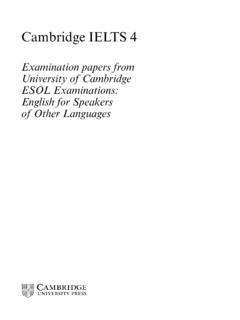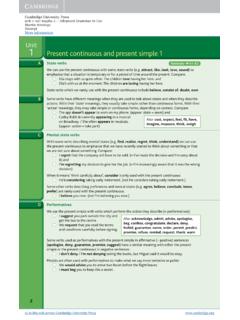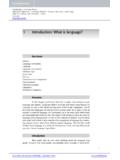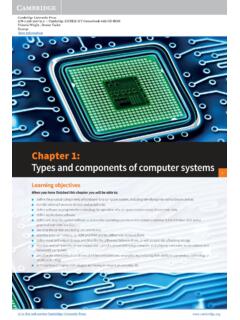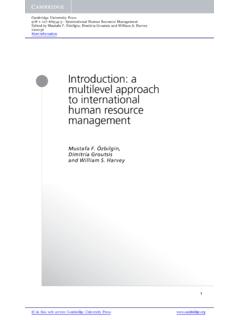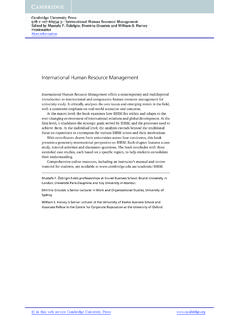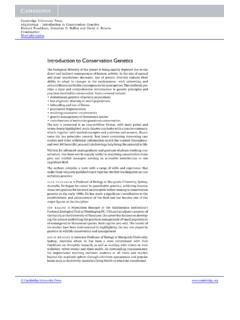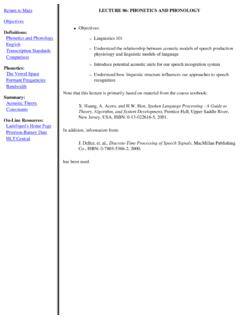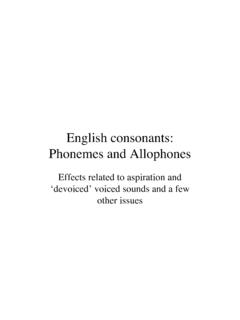Transcription of 2 The production of speech sounds
1 82 The production of speech Articulators above the larynxAll the sounds we make when we speak are the result of muscles contracting. The muscles in the chest that we use for breathing produce the flow of air that is needed for almost all speech sounds ; muscles in the larynx produce many different modifications in the flow of air from the chest to the mouth. After passing through the larynx, the air goes through what we call the vocal tract, which ends at the mouth and nostrils; we call the part comprising the mouth the oral cavity and the part that leads to the nostrils the nasal cavity. Here the air from the lungs escapes into the atmosphere. We have a large and complex set of muscles that can produce changes in the shape of the vocal tract, and in order to learn how the sounds of speech are produced it is necessary to become familiar with the different parts of the vocal tract.
2 These different parts are called articulators, and the study of them is called articulatory 1 is a diagram that is used frequently in the study of phonetics . It represents the human head, seen from the side, displayed as though it had been cut in half. You will need to look at it carefully as the articulators are described, and you will find it useful to have a mirror and a good light placed so that you can look at the inside of your ) The pharynx is a tube which begins just above the larynx. It is about 7 cm long in women and about 8 cm in men, and at its top end it is divided into two, one 8 Fig. 1 The articulatorsupperteethalveolarridgehardp alatesoft palate (velum)pharynxlarynxtonguelower lipupper lipnoselower teeth Cambridge University University Press978-0-521-71740-3 - english phonetics and phonology : A Practical Course, Fourth EditionPeter RoachExcerptMore informationpart being the back of the oral cavity and the other being the beginning of the way through the nasal cavity.
3 If you look in your mirror with your mouth open, you can see the back of the ) The soft palate or velum is seen in the diagram in a position that allows air to pass through the nose and through the mouth. Yours is probably in that position now, but often in speech it is raised so that air cannot escape through the nose. The other important thing about the soft palate is that it is one of the articulators that can be touched by the tongue. When we make the sounds k, the tongue is in contact with the lower side of the soft palate, and we call these velar ) The hard palate is often called the roof of the mouth . You can feel its smooth curved surface with your tongue. A consonant made with the tongue close to the hard palate is called palatal.
4 The sound j in yes is ) The alveolar ridge is between the top front teeth and the hard palate. You can feel its shape with your tongue. Its surface is really much rougher than it feels, and is covered with little ridges. You can only see these if you have a mirror small enough to go inside your mouth, such as those used by dentists. sounds made with the tongue touching here (such as t, d, n) are called ) The tongue is a very important articulator and it can be moved into many dif-ferent places and different shapes. It is usual to divide the tongue into different parts, though there are no clear dividing lines within its structure. Fig. 2 shows the tongue on a larger scale with these parts shown: tip, blade, front, back and root.
5 (This use of the word front often seems rather strange at first.)vi) The teeth (upper and lower) are usually shown in diagrams like Fig. 1 only at the front of the mouth, immediately behind the lips. This is for the sake of a simple diagram, and you should remember that most speakers have teeth to the sides of their mouths, back almost to the soft palate. The tongue is in contact with the upper side teeth for most speech sounds . sounds made with the tongue touching the front teeth, such as english , , are called 2 Subdivisions of the tongue The production of speech sounds 9 Cambridge University Press Cambridge University University Press978-0-521-71740-3 - english phonetics and phonology : A Practical Course, Fourth EditionPeter RoachExcerptMore information10 english phonetics and Phonologyvii) The lips are important in speech .
6 They can be pressed together (when we produce the sounds p, b), brought into contact with the teeth (as in f, v), or rounded to produce the lip-shape for vowels like u . sounds in which the lips are in contact with each other are called bilabial, while those with lip-to-teeth contact are called seven articulators described above are the main ones used in speech , but there are a few other things to remember. Firstly, the larynx (which will be studied in Chapter 4) could also be described as an articulator a very complex and independent one. Secondly, the jaws are sometimes called articulators; certainly we move the lower jaw a lot in speak-ing. But the jaws are not articulators in the same way as the others, because they cannot themselves make contact with other articulators.
7 Finally, although there is practically noth-ing active that we can do with the nose and the nasal cavity when speaking, they are a very important part of our equipment for making sounds (which is sometimes called our vocal apparatus), particularly nasal consonants such as m, n. Again, we cannot really describe the nose and the nasal cavity as articulators in the same sense as (i) to (vii) Vowel and consonantThe words vowel and consonant are very familiar ones, but when we study the sounds of speech scientifically we find that it is not easy to define exactly what they mean. The most common view is that vowels are sounds in which there is no obstruction to the flow of air as it passes from the larynx to the lips.
8 A doctor who wants to look at the back of a patient s mouth often asks them to say ah ; making this vowel sound is the best way of presenting an unobstructed view. But if we make a sound like s, d it can be clearly felt that we are making it difficult or impossible for the air to pass through the mouth. Most people would have no doubt that sounds like s, d should be called consonants. However, there are many cases where the decision is not so easy to make. One problem is that some english sounds that we think of as consonants, such as the sounds at the beginning of the words hay and way , do not really obstruct the flow of air more than some vowels do. Another problem is that different languages have different ways of dividing their sounds into vowels and consonants; for example, the usual sound produced at the beginning of the word red is felt to be a consonant by most english speakers, but in some other lan-guages ( Mandarin Chinese) the same sound is treated as one of the we say that the difference between vowels and consonants is a difference in the way that they are produced, there will inevitably be some cases of uncertainty or disagreement; this is a problem that cannot be avoided.
9 It is possible to establish two distinct groups of sounds (vowels and consonants) in another way. Consider english words beginning with the sound h; what sounds can come next after this h? We find that most of the sounds we normally think of as vowels can follow ( e in the word hen ), but practically none of the sounds we class as consonants, with the possible exception of j in a word such as huge hju d . Now think of english words beginning with the two sounds bi; we find many cases where a consonant can follow ( d in the word bid , or l in the word bill ), Cambridge University University Press978-0-521-71740-3 - english phonetics and phonology : A Practical Course, Fourth EditionPeter RoachExcerptMore information 2 The production of speech sounds 11but practically no cases where a vowel may follow.
10 What we are doing here is looking at the different contexts and positions in which particular sounds can occur; this is the study of the distribution of the sounds , and is of great importance in phonology . Study of the sounds found at the beginning and end of english words has shown that two groups of sounds with quite different patterns of distribution can be identified, and these two groups are those of vowel and consonant. If we look at the vowel consonant distinction in this way, we must say that the most important difference between vowel and consonant is not the way that they are made, but their different distributions. It is important to remember that the distribution of vowels and consonants is different for each language.

